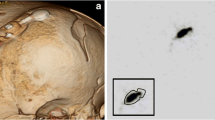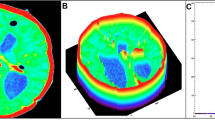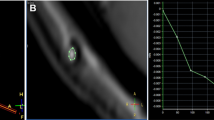Abstract
Purpose
Pediatric shunt malfunction occurs frequently and is important to recognize due to the high associated morbidity and mortality. Although neuroimaging plays a crucial role in the diagnosis, it remains imperfect. We sought to identify the effect of image fusion software in predicting shunt malfunction.
Methods
A total of 248 rapid shunt series brain MRIs performed between 2013 and 2017 were compared with prior neuroimaging for changes in ventricular size by two methods: radiology report and Brainlab fusion. Shunt malfunction was defined by an operative report confirming malfunction within 72 h of neuroimaging. The two methods were compared by logistic regression models, with sensitivity and specificity subsequently calculated.
Results
Shunt malfunction was identified in 40 cases (16.1%). Imaging report demonstrated a lower Akaike information criterion than the Brainlab fusion and is therefore a better fitting model. While sensitivity is similar for the two models, 0.94 (0.90 to 0.97, 95% CI) for imaging report, and 0.95 (0.91 to 0.98, 95% CI) for Brainlab, the specificity was significantly different, 0.50 (0.37 to 0.63, 95% CI) and 0.33 (0.24 to 0.44, 95% CI) respectively.
Conclusions
Our data indicate that an increased ability to detect subtle changes in ventricular size does not translate to improved accuracy, but instead leads to decreased specificity, and therefore an overdiagnosis of shunt malfunction in children with normally functioning shunts. While imaging continues to play a prominent role in the identification of shunt malfunction, neurosurgical clinical evaluation remains crucial to the final diagnosis.



Similar content being viewed by others
References
Shah SS, Hall M, Slonim AD, Hornig GW, Berry JG, Sharma V (2008) A multicenter study of factors influencing cerebrospinal fluid shunt survival in infants and children. Neurosurgery 62(5):1095–1102. https://doi.org/10.1227/01.neu.0000325871.60129.23
Tuli S, Drake J, Lawless J, Wigg M, Lamberti-Pasculli M (2000) Risk factors for repeated cerebrospinal shunt failures in pediatric patients with hydrocephalus. J Neurosurg 92(1):31–38. https://doi.org/10.3171/jns.2000.92.1.0031
Kim TY, Stewart G, Voth M, Moynihan JA, Brown L (2006) Signs and symptoms of cerebrospinal fluid shunt malfunction in the pediatric emergency department. Pediatr Emerg Care 22(1):28–34. https://doi.org/10.1542/peds.2013-373
Boyle TP, Paldino MJ, Kimia AA, Fitz BM, Madsen JR, Monuteaux MC, Nigrovic LE (2014) Comparison of rapid cranial MRI to CT for ventricular shunt malfunction. Pediatrics 134(1):e47–e54
Lehnert BE, Rahbar H, Relyea-Chew A, Lewis DH, Richardson ML, Fink JR (2011) Detection of ventricular shunt malfunction in the ED: relative utility of radiography, CT, and nuclear imaging. Emerg Radiol 18(4):299–305. https://doi.org/10.1007/s10140-011-0955-6
Mater A, Shroff M, Al-Farsi S, Drake J, Goldman RD (2008) Test characteristics of neuroimaging in the emergency department evaluation of children for cerebrospinal fluid shunt malfunction. CJEM 10(2):131–135
McNatt SA, Kim A, Hohuan D, Krieger M, McComb JG (2008) Pediatric shunt malfunction without ventricular dilatation. Pediatr Neurosurg 44:128–132. https://doi.org/10.1159/000113115
Winston KR, Lopez JA, Freeman J (2006) CSF shunt failure with stale normal ventricular size. Pediatr Neurosurg 42:151–155. https://doi.org/10.1159/000091857
Erickson BJ, Patriarche J, Wood C, Campeau N, Lindell EP, Savcenko V, Arslanlar N, Wang L (2007) Image registration improves confidence and accuracy of image interpretation. Cancer Informat 4:19–24
Erickson BJ, Wood CP, Kaufmann TJ, Patriarche JW, Mandrekar J (2011) Optimal presentation modes for detecting brain tumor progression. AJNR Am J Neuroradiol 32(9):1652–1657. https://doi.org/10.3174/ajnr.A2596
Galletto Pregliasco A, Collin A, Guéguen A, Metten MA, Aboab J, Deschamps R, Gout O, Duron L, Sadik JC, Savatovsky J, Lecler A (2018) Improved detection of new MS lesions during follow-up using an automated MR coregistration-fusion method. AJNR Am J Neuroradiol 39(7):1226–1232. https://doi.org/10.3174/ajnr.A5690
Schellingerhout D, Lev MH, Bagga RJ, Rincon S, Berdichevsky D, Thangaraj V, Gonzalez RG, Alpert NM (2003) Coregistration of head CT comparison studies: assessment of clinical utility. Acad Radiol 10(3):242–248
Iskandar BJ, McLaughlin C, Mapstone TB, Grabb PA, Oakes WJ (1998) Pitfalls in the diagnosis of ventricular shunt dysfunction: radiology reports and ventricular size. Pediatrics 101:1031–1036. https://doi.org/10.1542/peds.101.6.1031
Bateman GA (2013) Hypertensive slit ventricle syndrome: pseudotumor cerebri with a malfunctioning shunt? J Neurosurg 119(6):1503–1510. https://doi.org/10.3171/2013.7.JNS13390
Funding
Funding support for Maxene Meier is provided by the Children’s Hospital Center for Research in Outcomes in Children’s Surgery.
Author information
Authors and Affiliations
Corresponding author
Ethics declarations
Conflict of interest
The authors declare that they have no conflict of interest.
Additional information
Publisher’s note
Springer Nature remains neutral with regard to jurisdictional claims in published maps and institutional affiliations.
Rights and permissions
About this article
Cite this article
Neuberger, I., Hankinson, T.C., Meier, M. et al. Utility of image fusion software in identifying shunt malfunction. Childs Nerv Syst 36, 749–754 (2020). https://doi.org/10.1007/s00381-019-04385-9
Received:
Accepted:
Published:
Issue Date:
DOI: https://doi.org/10.1007/s00381-019-04385-9




